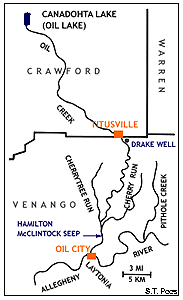 |
||||||
Oil Creek Before Drake's Well
Before E.L. Drake's well of 1859, many attempts to retrieve oil at a seep site on the east side of Oil Creek near Titusville, Pennsylvania, had taken place. Beginning with nearby pits by Native Americans in the deep past, infrequent gathering of it was continued by early settlers and passers-by. The seep oil was used meagerly by a local saw mill of Brewer and Watson and at other places for lighting and lubrication of machinery. It had some early medicinal use too, such as a purge and balm. Some hawkers claimed that it could cure everything. It was called Seneca Oil.
Joel D. Angier from Titusville leased the seep from the saw mill principals on July 4, 1853, thus transacting the first petroleum lease in the United States. Oil was never collected in sufficient amount to make the operation economic. Angier gave up. However, some oil from this seep and much more oil from many other seeps as well as from distant salt borings had made its way to commercial centers. Crude oil attracted attention and finally stimulated serious experimentation as to its use and theories as to its extraction.
Another seep on Oil Creek, in fact directly in the middle of the lower stretch of the creek, was being exploited by the farm owner, Hamilton McClintock, since the early 1800's. The oil seeped upward from the rock through the alluvium and burst to the water's surface. Hamilton McClintock trapped some of it in a ring of timbers and baffles around the main seep. Twenty to thirty barrels could be caught in a season according to historian Paul Giddens (1938). This was the largest petroleum operation on Oil Creek prior to Drake's well. In 1854, the Hamilton McClintock seep was deemed very desirable by one man in the fledgling oil group from New York and Connecticut who visited the area, but the $7000 asking price was too much for the pocket book at that moment.
Just seeing McClintock's seep along with the seep upstream at the Brewer & Watson sawmill helped to create the enthusiasm that fired the process leading to the investment in oil. Albert Crosby, acting as agent for George H. Bissell of New York, reluctantly gave up the H. McClintock seep but commenced negotiations for the purchase of 100 acres around the seep near Titusville which Drake was later to drill on. Local people were astonished at the sale price of $5000 for "worthless" land where walkers always had to clean messy oil off their boots.
 |
The source of Oil Creek was Oil Lake, now named Canadohta Lake. Not all of the creek valley became oil belt, but the stretch from Titusville to Oil City was where the first and greatest activity occurred. An oil seep south of Titusville (Drake drilled there) and the Hamilton McClintock seep (directly in the lower creek) were the most famous in the valley. Oil Creek debouches into the Allegheny River at Oil City. |
| © 2004, Samuel T. Pees all rights reserved |
|